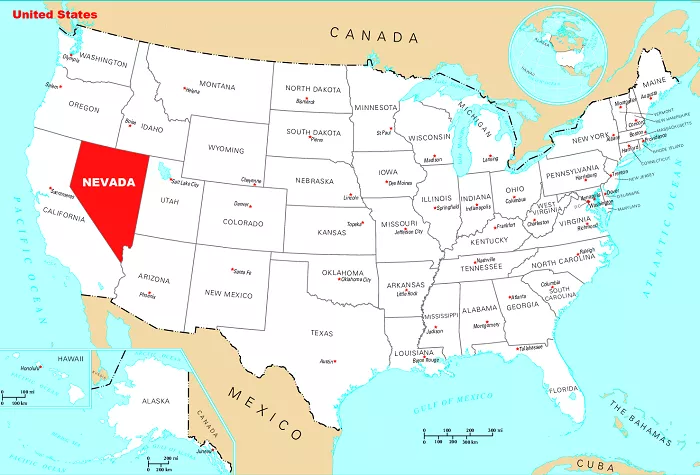Nevada, often referred to as the “Silver State,” is located in the western region of the United States. It is known for its vast deserts, mountain ranges, and vibrant cities like Las Vegas and Reno. Understanding Nevada’s geographical position provides insight into its climate, culture, and economic significance.
Geographical Location of Nevada
Nevada is situated in the western part of the United States, within the region known as the Great Basin. It shares borders with five states:
- California: To the west, Nevada shares a lengthy border with California, influencing cultural and economic exchanges between the two states.
- Oregon: The northwestern boundary of Nevada meets Oregon, though this border is relatively short compared to others.
- Idaho: To the north, Nevada is bordered by Idaho, with the border defined by the 42nd parallel north.
- Utah: The eastern border of Nevada adjoins Utah, following the 114th meridian west.
- Arizona: To the southeast, Nevada shares a border with Arizona, partially defined by the Colorado River.
The state’s coordinates range from approximately 35°N to 42°N latitude and 114°W to 120°W longitude. This positioning places Nevada within the Mountain West subregion of the western United States.
Size and Shape
Nevada is the seventh-largest state in the U.S., covering an area of about 110,577 square miles (286,382 square kilometers). Its shape resembles a trapezoid, with the southern tip narrowing near the convergence of California and Arizona. The state’s maximum width is approximately 322 miles (519 kilometers), and it stretches about 492 miles (787 kilometers) from north to south.
Major Cities and Regions
Nevada’s diverse landscape includes bustling urban centers and expansive rural areas:
- Las Vegas: Located in the southern part of the state, Las Vegas is Nevada’s largest city, renowned for its vibrant entertainment industry and bustling tourism sector.
- Reno: Situated in the western region, near the Sierra Nevada mountains, Reno is known as “The Biggest Little City in the World” and serves as a hub for gaming and outdoor activities.
- Carson City: As the state capital, Carson City lies south of Reno and offers rich historical insights into Nevada’s past.
- Elko: In northeastern Nevada, Elko is a center for ranching and gold mining, reflecting the state’s rural heritage.
Natural Features
Nevada’s terrain is characterized by:
- Mountain Ranges: The state hosts over 300 mountain ranges, with the Sierra Nevada to the west and the Ruby Mountains in the northeast. Boundary Peak, at 13,140 feet (4,005 meters), is the highest point in Nevada.
- Deserts: Much of Nevada lies within the Great Basin Desert, contributing to its arid climate and unique ecosystems.
- Lakes and Rivers: Significant water bodies include Lake Tahoe on the western border and the Colorado River along the southeastern edge, which feeds into Lake Mead.
Climate
Nevada experiences a predominantly arid climate, with:
- Low Precipitation: Most areas receive less than 10 inches (250 millimeters) of rainfall annually.
- Temperature Variations: Hot summers, especially in southern regions like Las Vegas, and cold winters with snowfall in higher elevations.
Economic Significance
Nevada’s economy is diverse, with key sectors including:
- Tourism and Entertainment: Las Vegas and Reno attract millions of visitors annually, bolstering the state’s revenue.
- Mining: Known as the “Silver State,” Nevada has a rich history of mining, leading in the production of gold and silver.
- Agriculture: Ranching and farming contribute to the state’s rural economy, with cattle and alfalfa being primary products.
Transportation and Accessibility
Nevada’s location facilitates various transportation networks:
- Interstate Highways: Major routes like I-15 and I-80 traverse the state, connecting it to neighboring regions.
- Air Travel: McCarran International Airport in Las Vegas and Reno-Tahoe International Airport serve as primary air travel hubs.
- Railroads: Freight and limited passenger services operate, supporting commerce and connectivity.
Conclusion
Understanding Nevada’s position on the map reveals its strategic importance in the western United States, offering a blend of natural beauty, economic opportunities, and cultural richness.

